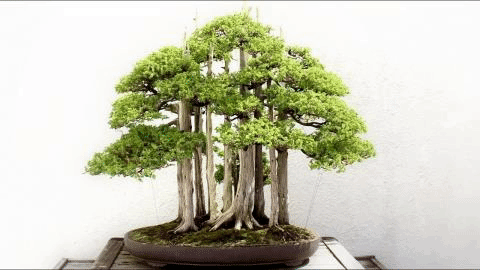Picking up from where we left off last time in my Rainventure, I've purchased a couple of inexpensive first-year conifers.
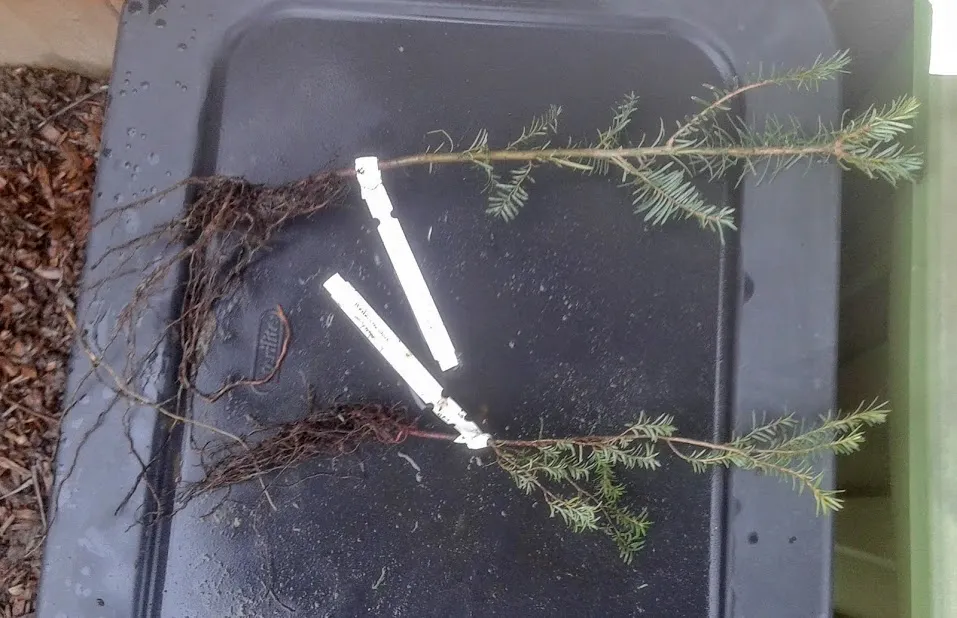
In this article I will walk through the process I go through to quickly plant them into a pot, and eventually train them into #bonsai #trees. Near the end, I'll include some interesting details about the characteristics of each type of #tree. Both of these trees have some incredible #natural-medicine properties.
In the photo above I laid out the trees sideways to analyze their size and shape, and to compare the two trees to help me identify them. On top is a #Grand-Fir. Below is a #Western-Hemlock.
First thing to do after looking at the sizes of the trees and #roots, is to pick suitable pots the trees can fit into.
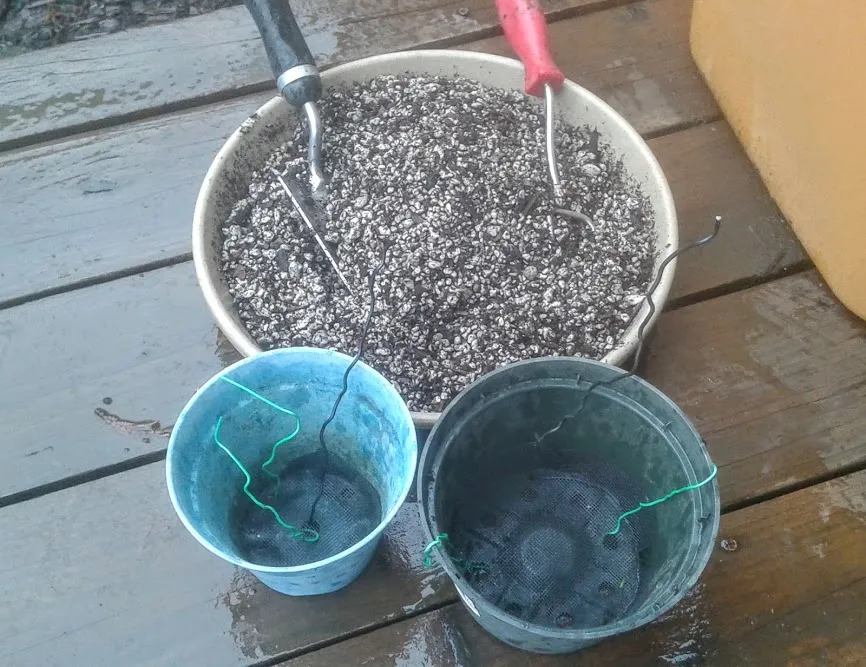
Above are the pots I selected. I picked normal tall edge nursery pots, because I want to make sure that these young trees do not dry out too quickly or get too cold. The holes are very big to allow for fast drainage. Screens were cut out to the shape of the base to help prevent soil from spilling out the bottom. Wires are strung through to help hold the tree in place. Aluminum wires of a thicker gauge were also shaped through the pot to help bend the tree shape if I decide to do so.
The soil is my own mix of mostly #pumice mixed in with a commercial bonsai mix I have (decomposed fir bark, sphagnum moss, redwood bark, sand, lava rock). Lava rock, is actually a generic term, I recently learned at bonsai club. This mix has four different colors of lava rock, and that could mean it is pumice, obsidian, red lava rock, black lava rock, etc.. Any type of rock that was blasted from a volcano and has porous holes made from molten bubbles can be termed as a lava rock.
These trees prefer a dry soil, and not super wet. That is why I am using more rock type soil than organic soil. Conifers also love old slow-decomposing wood, like bark, and benefit from the minerals of decomposed granite, which I added a sprinkling of. I also add a sprinkling of Azomite minerals for good measure.

When I go about placing the tree inside the pot, I notice right away the roots are way too long and stringy. These trees were grown in a long narrow sleeve, forcing all the roots to go down long and deep. It also caused the roots to grow in a parallel shape straight down, which is not good for the future health of the tree. It needs roots to spread out sideways, and roots need to be space out apart, so they can absorb the maximum allowed in the space they are given.
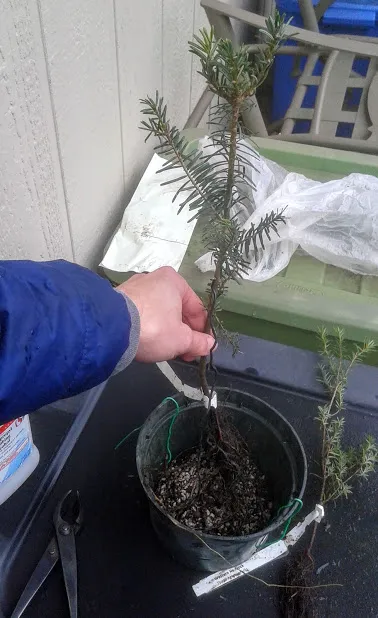
As much as I don't want to harm this young tree, the roots will have to be pruned to fit the size of this pot. The roots are far too long for a tree this size. Reducing the roots will take out some energy from the tree, and help it grow a bit slower, which is good for bonsai. If I over-do it, I could kill the tree by starving it, or by introducing an infection that would rot the tree.
Using some alcohol and some cotton wipes, I sterilize my bonsai cutters. With clean cuts, hopefully the roots will heal and begin to divide into smaller healthy roots, and the tree will not become infected with disease.
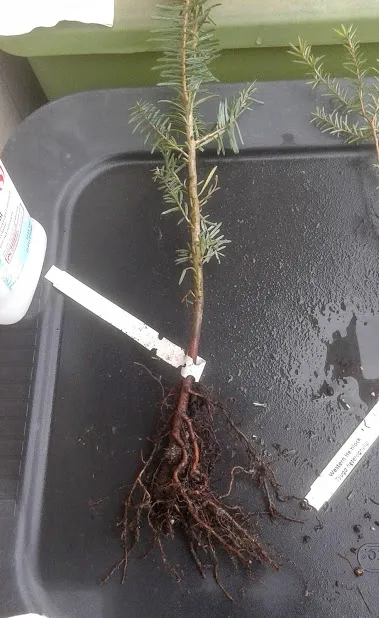
This is the fir tree after I pruned the roots down to the size of the pot. With my fingers I also teased the roots a little bit to untangle them from braiding around each other. I want the fatter roots on the sides to start stretching more into a diagonal shape through the #soil, instead of straight down.
I chose to leave the roots unwashed, because they may contain beneficial #mycorrhizae, a fungus possibly unique to this species of tree that it needs in order to absorb nutrients.
Recently I learned that for some trees, like the native Juniper to my area, are completely unable to survive without a single specific type mycorrhizae, which is different than the commercial type sold in stores. Growing some trees from seed, without the correct type of #beneficial-fungus, it will definitely starve and die. Plants and #fungus form a #symbiotic relationship, by the fungus feeding nutrients to plant from the soil it decomposes, and the plant in trade can offer sugars made through #photosynthesis. Not all type of fungus are the same, and certain tree species can only grow in certain locations, because they can only exist with the specific type of perfect fungus that lives in that soil.
In most cases, it is best to simply collect some soil near the mother plant, and mix that into the new potting soil, and that will ensure that a new colony of the helpful fungus will grow. Some people also recommend making a compost tea out of the dirt, and pouring that into the new potting soil.
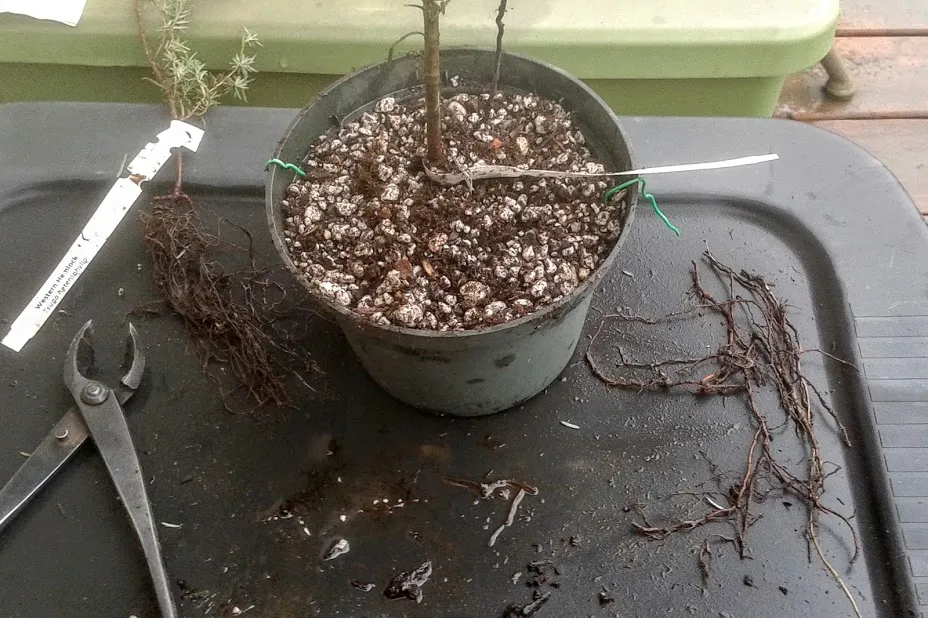
The rain outside was really starting to hinder my concentration. Above is the Fir tree after I added in the soil. I forgot to twist the #wires to secure the tree in place. I also had not spent any time thinking about the front of the tree, or its future design style. It never occurred to me that I could have planted this tree on a diagonal angle. My goal was to get this tree's roots covered by soil as quickly as I could manage on this cold, rainy day.
Beside the tree, you can see the amount of roots that were removed. Cutting the flexible roots, they had the consistency of really hard wire.

This is what the finished tree looks like after planting.
Things were going through my head very quickly, because I wanted to finish and get out of the rain. I could tell something wasn't quite finished with this tree yet. It doesn't exactly look like a spectacular tree I want to show off yet, so I moved onto the next tree to see if I could figure it out.
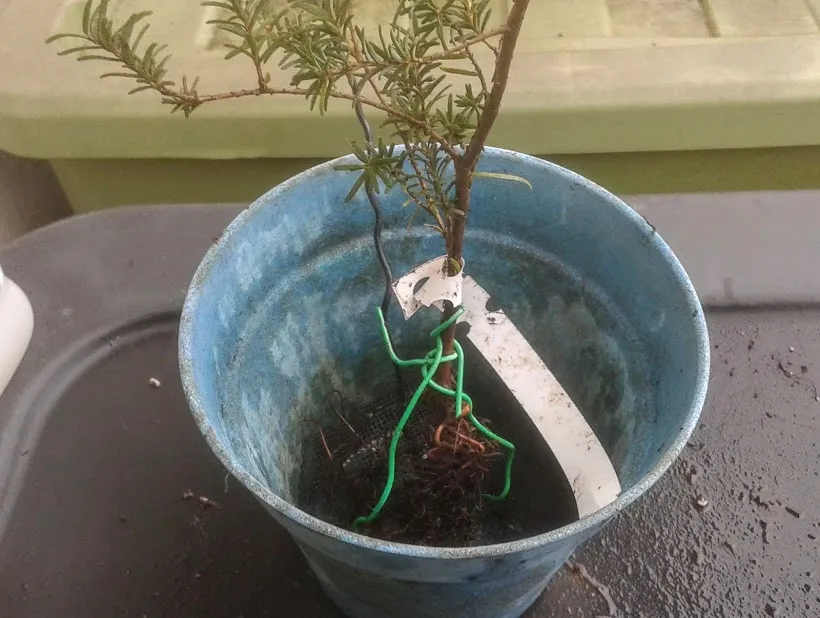
Next I looked at the #Hemlock tree. It's roots were not nearly as long, and would require no more than an inch to be pruned off the bottom length. Before trimming, I made sure to clean off and sterilize my pruners again.
Here you can see the green wires had to be twisted around the trunk in order to suspend the tree in the soil. I did not think pinning the roots down with the wire would be a good plan. A tree wants to be feel very earthquake-proof so it does not jiggle in the soil, and I think this was the best way to do it for a first year tree.
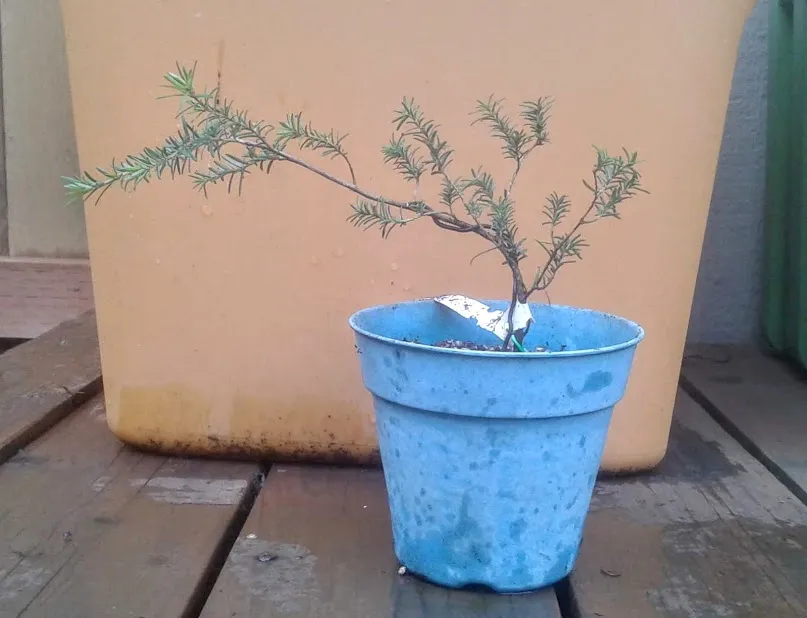
Voila!
Using the wire, I spiraled around the trunk and added a bend. Already, this looks like a much more natural form to me. With most of the #branches growing on one side, the needles are better positioned now to seek the sun in all directions. The side underneath the #trunk has a nice clean line, without any #pruning marks. Very ideal!
Western Hemlock is a very interesting tree species. It is a unique species that only grows on the coastal regions of the Pacific Northwest of USA and Canada. If found in the forest, it can be an extremely useful survival plant. Underneath the bark, the #cambium can be eaten. Native Americans used to use it as a substitute for flour to bake into a bread. Hemlock grows on rotted logs and stumps, and creates a habitat for #edible-fungus, such as #chanterelles. Needles can be eaten, and put into a #tea as a source of vitamin C. Boughs of the tree often weave into a blanket of flexible #needles. Fish trappers use these limbs to catch delicious herring eggs, which the fish love to lay their eggs on. It is an amazingly useful tree to have growing in the forest, which benefits many animals.
These trees are identifiable by the shorter needles. The branches often arch out horizontal, then upwards at the tips, with hanging mats of more narrow needle-covered branches hanging down underneath, resembling beards or fur under branch arms.
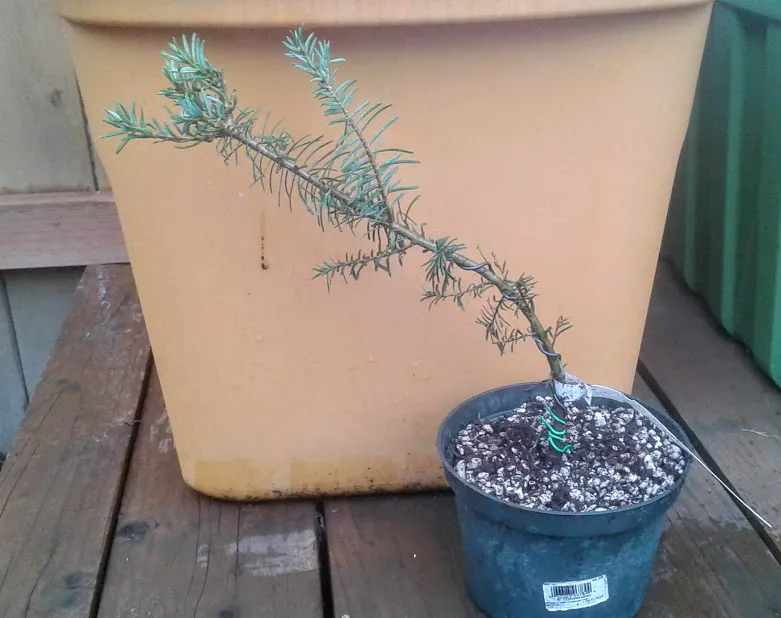
Using the same wire technique, I decided to bend this tree as well. I'm wishing I planted this tree at an angle, but there is no time for that now. Even my camera was getting muddy from the rain. I'll have to keep an eye on this tree to see how it develops.
Grand #Fir is known for being a popular #Christmas tree variety. It responds well to pruning, and should be easy to coax into making many back buds. As the tree is pruned more, it makes more buds, and that makes the tree look more full and bushy with lots of branches with lots of needles. Without pruning, its normal habit is to grow very straight and tall from a central leader, becoming more pole-like. Needles have a frosty-blue-green tint. Trees in the fir tree family are also known for having a top that slightly bends, or weeps to the side, although I do not notice that so much with Grand Fir's very upright tendency. The foliage has a slightly sweet citrus scent, which might be why it is popular to use in Christmas decorations. Native Americans used to use the inner bark as a treatment for colds and #fever.
Mature trees will have a beam straight trunk, with neatly layered horizontal branches. The trunk is easily visible through the branches, because there is an evenly open space between all branches. Branches, to me, resemble the many stores of a tall building. Needles are not sharp, and are about an inch long.
This concludes my update on my recent bonsai activities. Many of my trees are getting ready to open their first leaves and flowers from the buds. It's a very exciting time of year filled with anticipation after the long winter.
Be on the look out for future bonsai posts from me in the future.
#art #creative #creativity #photography #how-to #learning #instruction #tutorial #blog #collection
Photos in this post are all #originalworks by @creativetruth, unless stated otherwise.
Find me on discord and chat with other tree growers, bonsai enthusiasts, and gardeners. We have quite a few accredited experts filling out our ranks, and a helpful Spanish-speaking community.
